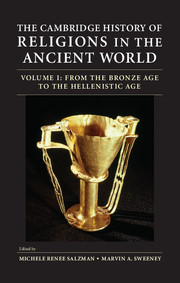Book contents
- Frontmatter
- Contents
- List of Figures and Maps
- List of Contributors
- List of Abbreviations
- Acknowledgments
- Introduction to Volumes I and II
- Introduction to Volume I
- Part I Mesopotamia and the Near East
- Part II Egypt and North Africa
- 7 Egyptian Religion
- 8 Phoenician-Punic Religion
- Part III Greece and the Eastern Mediterranean
- Part IV The Western Mediterranean and Europe
- Suggestions for Further Reading
- General Index
- Index of Citations
- Frontmatter
- Contents
- List of Figures and Maps
- List of Contributors
- List of Abbreviations
- Introduction to Volume II
- Part I Iran and the Near East
- Part II Egypt and North Africa
- Part III Greece and Asia Minor
- Part IV Italy, Roman Gaul, and Spain
- Suggestions for Further Reading
- General Index
- Index of Citations
- References
7 - Egyptian Religion
from Part II - Egypt and North Africa
Published online by Cambridge University Press: 05 October 2013
- Frontmatter
- Contents
- List of Figures and Maps
- List of Contributors
- List of Abbreviations
- Acknowledgments
- Introduction to Volumes I and II
- Introduction to Volume I
- Part I Mesopotamia and the Near East
- Part II Egypt and North Africa
- 7 Egyptian Religion
- 8 Phoenician-Punic Religion
- Part III Greece and the Eastern Mediterranean
- Part IV The Western Mediterranean and Europe
- Suggestions for Further Reading
- General Index
- Index of Citations
- Frontmatter
- Contents
- List of Figures and Maps
- List of Contributors
- List of Abbreviations
- Introduction to Volume II
- Part I Iran and the Near East
- Part II Egypt and North Africa
- Part III Greece and Asia Minor
- Part IV Italy, Roman Gaul, and Spain
- Suggestions for Further Reading
- General Index
- Index of Citations
- References
Summary
Along with its great antiquity, ancient Egyptian religion presents unique obstacles to interpretation. The absence of a coherent written doctrine has required scholars to rely on a variety of disparate sources, including funerary spells, literary works, instructional treatises, biographical inscriptions, artistic representations, and archaeological evidence to attempt to understand the ancient Egyptians’ relationship to the divine. Fortunately, Egypt’s climate and the Egyptians’ own practices have left an unusually rich corpus of textual and archaeological evidence.
The study of Egyptian religion is also complicated by the seemingly alien nature of Egyptian deities and beliefs when viewed from the perspective of cultures accustomed to an anthropomorphic deity or deities. From Greco-Roman times, representations of gods and goddesses with combined human and animal characteristics aroused confusion and suspicion. The esoteric nature of surviving funerary texts, with their enigmatic denizens of the afterlife, only increased the sense of alienation. In addition, the Egyptians’ understanding of their pantheon was subject to review and alteration over its three-thousand-year history. Towns and districts each worshipped their own deities and even held different beliefs regarding creation and the nature of the cosmos. In Lower Egypt the principal creator-god was Atum, the patron god of Heliopolis. At Memphis, the Memphite god Ptah was seen as a manifestation of Atum. Meanwhile in southernmost Egypt, Khnum, a god associated with the source of the Nile, was the primary creator. The Egyptians apparently saw no contradiction in the presence of multiple gods of creation. Deities therefore shared overlapping functions and characteristics, and two or more could share attributes. For example, Amen-Ra, the supreme state god of Egypt during the New Kingdom, arose from the combination of the traditional solar god Ra with the local god of Thebes, Amen, after Thebes became Egypt’s capital.
- Type
- Chapter
- Information
- The Cambridge History of Religions in the Ancient World , pp. 177 - 204Publisher: Cambridge University PressPrint publication year: 2013



